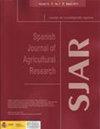花生收获品质:土壤耕作管理与脱粒系统的关系
IF 0.8
4区 农林科学
Q3 AGRICULTURE, MULTIDISCIPLINARY
引用次数: 0
摘要
研究目的:评价3种土壤耕作制度下花生组合的质量,并结合市场上花生组合的脱粒和分离制度的效率。研究地区:巴西。材料和方法:采用三种土壤耕作制度(常规、减少和条形)和两种不同脱粒制度的收割机。根据统计过程控制,在每个处理中以15个点收集损耗(按内部机制、拾取平台和总损耗进行细分),作为杂质样品。主要结果:仅播线土壤耕作降低了花生配种质量(矿物杂质增加30.4%,植物杂质增加37.7%)。无论土壤耕作制度如何,切向流的机器对矿物杂质的去除能力都较低。研究重点:常规耕作和减少土壤耕作的损失相似,这表明有可能减少花生播种前的农业作业次数,从而在不损失过程质量的情况下降低成本。本文章由计算机程序翻译,如有差异,请以英文原文为准。
Peanut harvest quality: Relationship between soil tillage management and threshing systems
Aim of study: The objective was evaluating the peanut combining process quality in three soil tillage systems associated with threshing and separation systems efficiency of peanut combine available on market.
Area of study: Brazil.
Material and methods: The treatments were three soil tillage systems (conventional, reduced and strip) and two harvesters with different threshing systems. The losses were collected (subdivided in internal mechanisms, pickup platform, and total losses) in fifteen points for each treatment, as impurity samples, following the statistical process control.
Main results: The soil tillage only in sowing line reduced the peanut combining quality (30.4% more mineral impurities and 37.7% more vegetal impurities). The machine with tangential flow presented lower capacity of mineral impurity removal, regardless the soil tillage system.
Research highlights: The losses were similar for conventional and reduced soil tillages, which indicates that it would be possible to reduce the number of agricultural operations before peanut sowing, consequently lessening costs without loss in process quality.
求助全文
通过发布文献求助,成功后即可免费获取论文全文。
去求助
来源期刊

Spanish Journal of Agricultural Research
农林科学-农业综合
CiteScore
2.00
自引率
0.00%
发文量
60
审稿时长
6 months
期刊介绍:
The Spanish Journal of Agricultural Research (SJAR) is a quarterly international journal that accepts research articles, reviews and short communications of content related to agriculture. Research articles and short communications must report original work not previously published in any language and not under consideration for publication elsewhere.
The main aim of SJAR is to publish papers that report research findings on the following topics: agricultural economics; agricultural engineering; agricultural environment and ecology; animal breeding, genetics and reproduction; animal health and welfare; animal production; plant breeding, genetics and genetic resources; plant physiology; plant production (field and horticultural crops); plant protection; soil science; and water management.
 求助内容:
求助内容: 应助结果提醒方式:
应助结果提醒方式:


